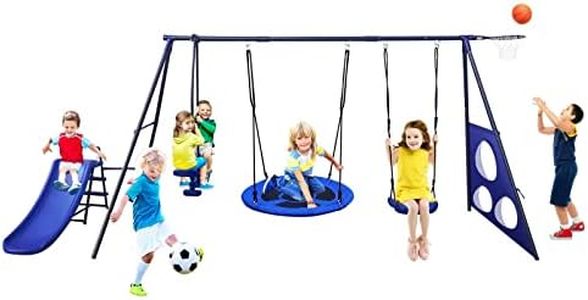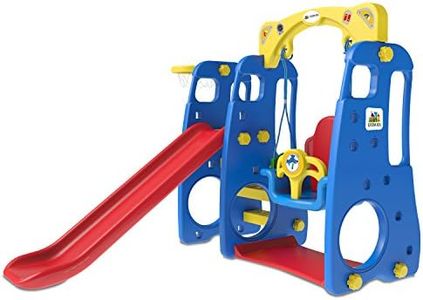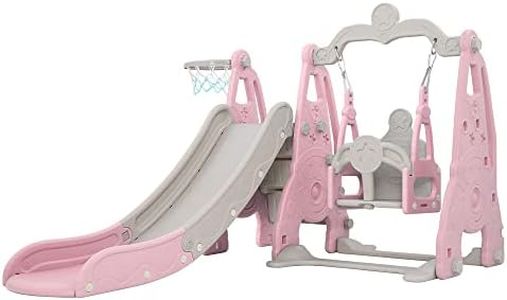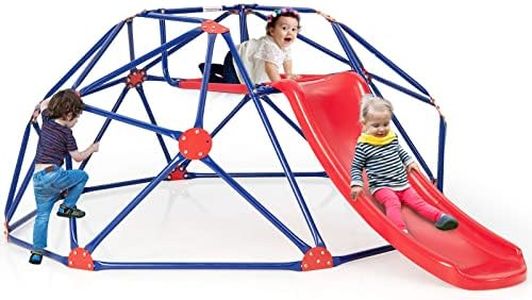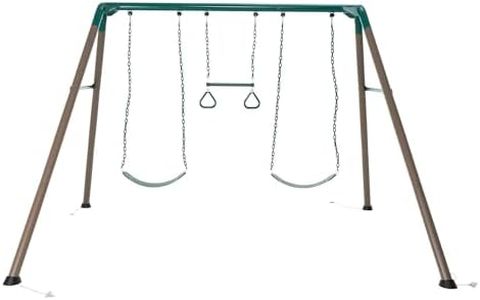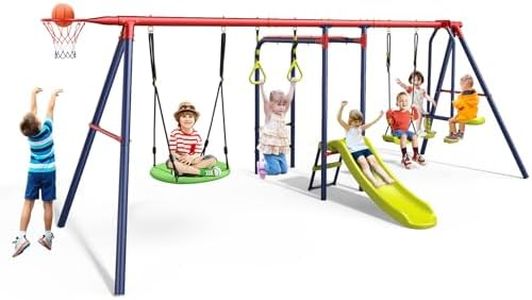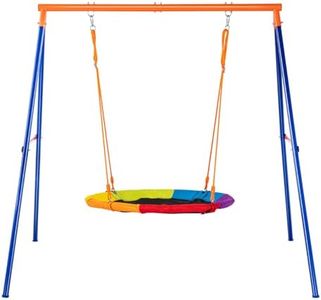We Use CookiesWe use cookies to enhance the security, performance,
functionality and for analytical and promotional activities. By continuing to browse this site you
are agreeing to our privacy policy
10 Best Backyard Swing Sets
From leading brands and best sellers available on the web.Buying Guide for the Best Backyard Swing Sets
Choosing the right backyard swing set can turn your outdoor space into a fun and safe play area for kids. The best set for you will depend on the space you have, the age and number of children using it, and the kinds of activities you want to offer. Focusing on the features that matter most to your family's needs will help you make a confident decision and ensure years of enjoyment.MaterialSwing sets are typically made from wood, metal, or plastic, and the material impacts durability, appearance, and maintenance. Wood is sturdy and blends well with natural landscapes but requires periodic maintenance to prevent weather damage. Metal sets are often affordable and more resistant to pests but can get hot in direct sunlight and may rust if not properly treated. Plastic sets are low-maintenance and good for younger children, though they're often less durable for older kids. Think about your climate, how much upkeep you're willing to do, and the longevity you want when deciding.
Size and FootprintThis refers to the overall dimensions and space needed for the swing set, including the play zone around it for safety. Larger sets offer more activities and room for more kids, but require a spacious backyard. Compact sets fit smaller yards but have fewer features. Always measure your available space, including a minimum safety buffer around the set, and consider how many children will use it at once to ensure comfort and safety.
Age RangeAge recommendations provide guidance on which sets are best for certain age groups, as features and safety requirements vary for toddlers versus older kids. Sets made for little ones are lower to the ground with simpler swings and slides, while those for older children have higher platforms, climbing walls, and more adventurous elements. Choose according to your children’s current age and consider whether you'd prefer a set that can 'grow' with them by reconfiguring or adding on as they get older.
Play FeaturesSwing sets can include swings, slides, climbing walls, monkey bars, playhouses, and more. The combination and number of features impact the play experience and appeal. Think about which activities your children enjoy most—simple swing and slide sets might suffice for younger or less adventurous kids, while a set with varied activities keeps older or multiple children more engaged. Reflecting on your kids’ preferences and how many will use the set can help you choose features that will get the most use.
SafetySafety involves the stability of the structure, the quality of materials, smooth edges, secure fastenings, and adherence to safety standards. Sets should be anchored to the ground, free from pinch points, and have sturdy hardware. Consider sets with certifications from recognized safety organizations. For peace of mind, inspect customer reviews for long-term safety feedback and always follow assembly instructions closely.
Ease of Assembly and MaintenanceThis relates to how simple or complex it is to put together the set and keep it in good condition. Some sets are designed for quick, tool-free assembly, while others require more advanced DIY skills or professional help. Maintenance varies by material; for example, wood needs sealing or staining, while metal and plastic mainly need cleaning and checking for loose parts. Assess your willingness or ability to assemble and care for the set when making your choice.
Weight Limit and CapacityThis indicates the maximum user weight the swing set can handle for each activity and the total number of children who can play safely at once. It’s important for safety and longevity, especially if you have several children or expect neighborhood friends to join. Pick a set whose weight limit and capacity match the number and age of intended users to prevent wear or injury.




